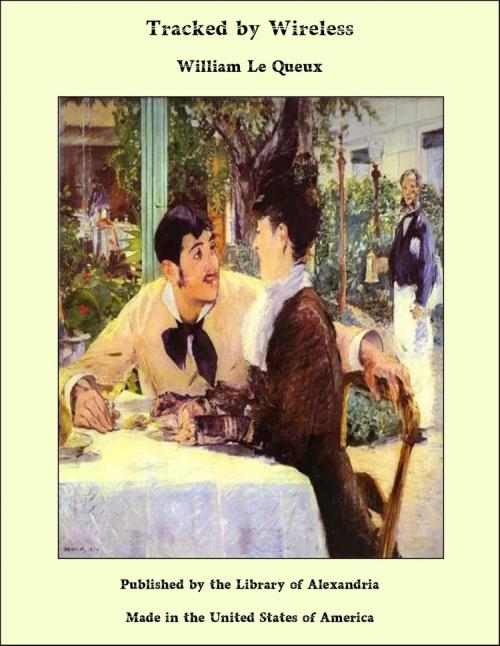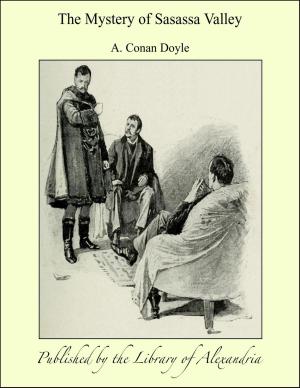| Author: | William Le Queux | ISBN: | 9781465627193 |
| Publisher: | Library of Alexandria | Publication: | March 8, 2015 |
| Imprint: | Language: | English |
| Author: | William Le Queux |
| ISBN: | 9781465627193 |
| Publisher: | Library of Alexandria |
| Publication: | March 8, 2015 |
| Imprint: | |
| Language: | English |
Geoffrey Falconer removed the wireless telephone receivers from his ears, and sat back in his wooden chair, staring straight before him, utterly puzzled. “Eighteen-and-a-half minutes past seven!” he muttered to himself, glancing up at the big round clock above the long bench upon which a number of complicated-looking wireless instruments were set out. In front of him were half-a-dozen square mahogany boxes with tops of ebonite and circles of brass studs, with white circular dials and black knobs and a panel of ebonite with four big electric globes for wireless transmission. Across the table ran many red, white, and green wires from a perfect maze of brass terminal screws, while in one oblong box there burned brightly seven little tube-shaped electric glow-lamps, the valves of the latest instrument which amplified the most feeble signals coming in from space from every part of the western world. It was the newest wireless device for the reception of weak signals and he himself had made an improvement upon it, a new microphone amplifier which was at present his own secret. “Eighteen-and-a-half minutes past seven!” he repeated. “Always at the same moment that strange signal is repeated three times. And not Morse—certainly not in the Morse code. It’s a most mysterious note,” he went on, speaking to himself. “Others must surely hear it—or else my amplifier is so ultra-sensitive that I alone am able to listen.” He took from near his elbow a long scribbling-diary, and glancing through its pages, noted various entries concerning that mysterious signal which never failed to come each evening at eighteen-and-a-half minutes past seven. That small private experimental laboratory in the ground floor room of a spacious country house on the brow of a low hill in Essex was well fitted with all kinds of apparatus for wireless telephony, telegraphy, and the newest invention of direction-finding for the guidance of aircraft in darkness or fog. The tall, clean-shaven, dark-eyed young man, whose hair was brushed back, and whose bearing was distinctly military, had done excellent service in the wireless department of the Royal Air Force, and had won his Military Cross. Before the war, at the age of nineteen, he had been a persevering amateur, keenly interested in the mysteries of wireless. His knowledge thus gained, with crystal receivers and “spark” transmitters, stood him in good stead; hence, during the war, he had held a number of responsible appointments connected with aircraft wireless. After demobilisation he had at once taken his degree in Science, and then joined the research department of the great Marconi organisation, in which he was showing excellent promise. Quiet and unassuming, he possessed for his age unusual technical and mathematical knowledge, and great things were being predicted of him by his superiors at Marconi House. Already he had made certain improvements in the application of the telephone to wireless, together with small adjustments and the use of condensers in certain circuits, technicalities which need not be referred to here because only the expert could follow their importance. Suffice it to say that Geoffrey Falconer’s whole heart was in his work. Though he did wireless all day in the great well-lit laboratory at the Chelmsford works, he nevertheless spent most of his evenings at his own private wireless station at his father’s house at Warley, about a mile from Brentwood, which was about ten miles from Chelmsford and twenty from London. Old Professor Falconer’s house, a Georgian one, half-covered with ivy and surrounded by several giant cedars, stood well back from the broad high road which runs from Brentwood Station through Great Warley Street to Upminster. Those who pass it will see a double-fronted house approached by a curved drive half-hidden from the road by a high yew hedge.
Geoffrey Falconer removed the wireless telephone receivers from his ears, and sat back in his wooden chair, staring straight before him, utterly puzzled. “Eighteen-and-a-half minutes past seven!” he muttered to himself, glancing up at the big round clock above the long bench upon which a number of complicated-looking wireless instruments were set out. In front of him were half-a-dozen square mahogany boxes with tops of ebonite and circles of brass studs, with white circular dials and black knobs and a panel of ebonite with four big electric globes for wireless transmission. Across the table ran many red, white, and green wires from a perfect maze of brass terminal screws, while in one oblong box there burned brightly seven little tube-shaped electric glow-lamps, the valves of the latest instrument which amplified the most feeble signals coming in from space from every part of the western world. It was the newest wireless device for the reception of weak signals and he himself had made an improvement upon it, a new microphone amplifier which was at present his own secret. “Eighteen-and-a-half minutes past seven!” he repeated. “Always at the same moment that strange signal is repeated three times. And not Morse—certainly not in the Morse code. It’s a most mysterious note,” he went on, speaking to himself. “Others must surely hear it—or else my amplifier is so ultra-sensitive that I alone am able to listen.” He took from near his elbow a long scribbling-diary, and glancing through its pages, noted various entries concerning that mysterious signal which never failed to come each evening at eighteen-and-a-half minutes past seven. That small private experimental laboratory in the ground floor room of a spacious country house on the brow of a low hill in Essex was well fitted with all kinds of apparatus for wireless telephony, telegraphy, and the newest invention of direction-finding for the guidance of aircraft in darkness or fog. The tall, clean-shaven, dark-eyed young man, whose hair was brushed back, and whose bearing was distinctly military, had done excellent service in the wireless department of the Royal Air Force, and had won his Military Cross. Before the war, at the age of nineteen, he had been a persevering amateur, keenly interested in the mysteries of wireless. His knowledge thus gained, with crystal receivers and “spark” transmitters, stood him in good stead; hence, during the war, he had held a number of responsible appointments connected with aircraft wireless. After demobilisation he had at once taken his degree in Science, and then joined the research department of the great Marconi organisation, in which he was showing excellent promise. Quiet and unassuming, he possessed for his age unusual technical and mathematical knowledge, and great things were being predicted of him by his superiors at Marconi House. Already he had made certain improvements in the application of the telephone to wireless, together with small adjustments and the use of condensers in certain circuits, technicalities which need not be referred to here because only the expert could follow their importance. Suffice it to say that Geoffrey Falconer’s whole heart was in his work. Though he did wireless all day in the great well-lit laboratory at the Chelmsford works, he nevertheless spent most of his evenings at his own private wireless station at his father’s house at Warley, about a mile from Brentwood, which was about ten miles from Chelmsford and twenty from London. Old Professor Falconer’s house, a Georgian one, half-covered with ivy and surrounded by several giant cedars, stood well back from the broad high road which runs from Brentwood Station through Great Warley Street to Upminster. Those who pass it will see a double-fronted house approached by a curved drive half-hidden from the road by a high yew hedge.















